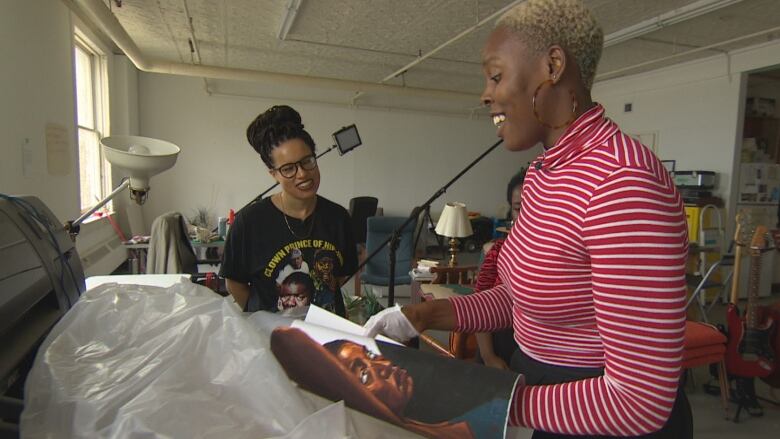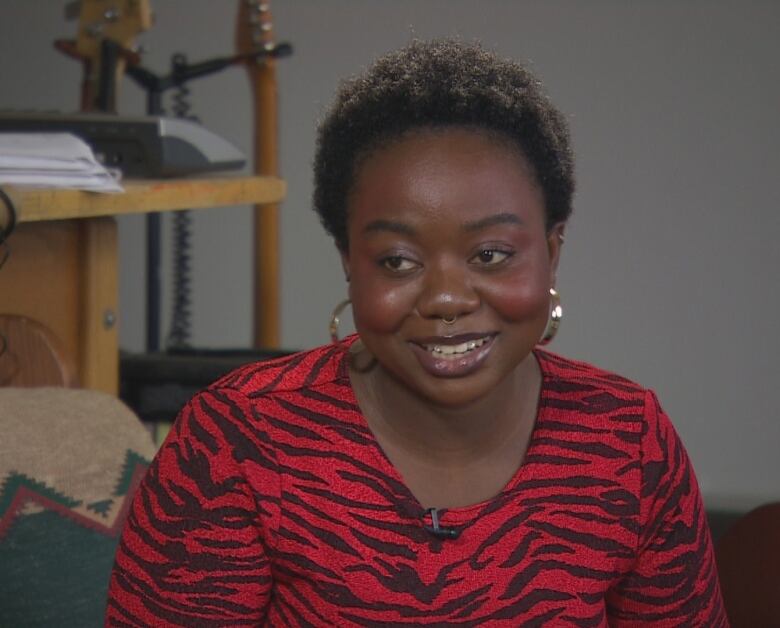Uncensored with Alexa Joy embraces Kinfolk 'a space for us'
Why a BIPOC-centred artist-run studio is changing Winnipeg's artistic landscape for the better

This column is an opinion byAlexa Joy, a researcher, journalistand graduate student at the New School for Social Research. For more information aboutCBC's Opinion section,please see theFAQ.
"It's very important that Black folks have agency over what they do. We don't have to tell people how to do it, or when it needs to be done we want to know how we can support the project."
Sappfyre Mcleod is a community organizer, artistand co-ordinator at Take Home, Winnipeg's first BIPOC(Black, Indigenous and people of colour) gallery in the historic Exchange District.
In 2021, Take Home emerged as a BIPOC-led and centred space. Its key objectives are to provide a space for growth, development and support of BIPOC artists, through programming, exhibitions and community projects.
One collective, in particular, was the inspiration for this segment of Uncensored: Kinfolk. Kinfolk operates as an incubated collectivein partnership with Take Home, and provides low-barrier access to programming and mentorship.
Take Home
I met with Take Home's Sappfyre Mcleodand one of Kinfolk's resident artists, Glodi Bahati, a Winnipeg-based photographereager to develop her practice to support and highlight Black women in her community.
"It always seemed like Black women around the city were the ones who were reaching out to meand offering support," Bahati told me. "I felt blessed by the Black folks in the art scene who have been anchors for meand very supportive."
Bahati and other Black artists in this collective make it a priority to support Black femme, trans, non-binary and queer voices in Winnipeg's art scene.

"One of the beauties of Take Home is that we understand this space isn't just for us. None of us own this space, in the sense that we exist for community," Mcleod said.
Take Home and Kinfolk are refreshing a needed change that has reshaped Winnipeg's artistic landscape.
As a former organizer in the city, I know curating Black-centred art spaces in Winnipeg comes with challenges.
One of the things that we've done is to centre people of colour.- SappfyreMcleod
If not for the tireless efforts of BIPOC artist collectives like Kinfolk, Ifear Winnipeg would be left in an era that refused to dismantle the eurocentrism in the Winnipeg art scene.
This common arts and institutional exclusion have often been felt among BIPOC artists, curators and arts administrators across the country. It made me think, what other barriers are operating in Winnipeg that hinder support forBIPOC artists, and how can we know if these barriers do exist?
Show us the funding
Two of the largest funding bodies for artists and arts collectives in Manitoba are the Winnipeg and Manitoba arts councils.
One of the major institutional barriers in supporting BIPOC artists is funding. Whatever art discipline it might be (i.e. installation, film, music, publishing), Winnipeg's funded arts community has historically struggled to prioritizeBIPOC artist support.
In fact, the Manitoba Arts Council (MAC) committed in a 2021-23 strategic priorities report to "refine program assessment criteria that favour a Eurocentric concept of excellence to instead focus on impact."
Sappfyresaid community donations helped support Take Home and Kinfolk, but funding needs to be stabilized to provide regular support for BIPOC artists.
"We're the only BIPOC physical space in the city," McLeod said. "A guiding principle for ourselves is or whiteness. For us to be successful, one of the things that we've done is to centre people of colour."
A visit to Take Home reminded me how having a space for the community to gather, curate, program events and provide roomfor artist development and growthgoes such a long way for emerging artists and the community at large.
"My work is very personal to my experience as a Black woman, and working with other Black women felt like a sigh of relief. Finally people can see me," Bahati told me.
I hope to see more BIPOC shows exploring community, colonialism.- Glodi Bahati
Bahati then shared her hopes for the future of Winnipeg's arts community.
"I hope to see more BIPOC shows exploring community, colonialism," she said. "I want the people who are affected by those stories to tell those stories, to be in charge of that story."
Agency, supportand development:key takeaways shared by the members of Take Home and Kinfolk, reminding all of Winnipeg's arts community to be mindful and think of ways to supportartistic inclusion for BIPOC artists.
One thing I hope moving forward is that initiatives like Take Home and Kinfolk are additionally supported and funded, making systemic changes for BIPOC artists for generations to come.
For more stories about the experiences of Black Canadians from anti-Black racism to success stories within the Black community check out Being Black in Canada, a CBC project Black Canadians can be proud of. You can read more stories here.














_(720p).jpg)


 OFFICIAL HD MUSIC VIDEO.jpg)
.jpg)



























































































